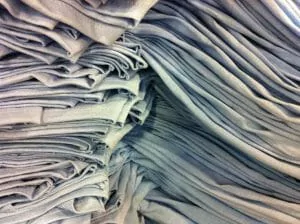A few months ago I was able to get some much needed help on a sustainability challenge that I have been struggling with for over a year. Our shop has a recycling program, and our goal is to move as much material waste as we can into recycling and not push it towards the landfill. We recycle many items in the shop (38+ tons this past year), but I wanted to turn the big four (cardboard, paper, plastic & metal) into the big five, by adding embroidery stabilizer (sometimes called pellon) to the mix. Embroidery stabilizer is the material used on the inside of the shirt or jacket to give the commercially sewn image the ability to be produced without puckering, stretching or distorting the fabric. The problem is that the stabilizer, although great for its intended purpose, has virtually no value after it’s been used. For all embroidery orders, after each order has been sewn, we have a group of trimmers that go through every garment and trim off the excess pellon material. Currently all this waste goes to landfill.
The pellon material is composed of cellulose and polyester fibers that are fused together with a chemical bonding agent that is similar to glue. Both the cellulose and polyester fibers are from recycled content already. However, because how the material is constructed the pellon can’t be commercially recycled by breaking it back down to its original components. You can’t take a biscuit and then later break it back down into flour, butter, salt, baking powder, and milk. A biscuit stays a biscuit. Pellon will stay a pellon. A biscuit is better with melted butter though. Maybe some honey too.
At the beginning of the year, I was able to get a University of Wisconsin business school class to adopt this challenge as part of a class project. A team of four students spent some time interviewing me, touring our facility, calling suppliers, vendors, and recycling experts to try to solve this recycling conundrum. Could the manufacturers construct the pellon differently so it could be recycled? Could there be a post-production process that could use the material somehow? How could the material be recycled – are there any options? Just what could we do with this stuff? I explained that this problem wasn’t just isolated to our shop, but really every commercial embroiderer as everyone just throws this material away. It’s all going to landfill. Everywhere. Could they find the magic bullet I was after? Here is their report (used with their permission):
Click here to watch their video presentation.
Final Report – Visual Impressions – Embroidery Stabilizer Diversion
Report by: Jon Goeres, Sue Montgomery, Colton Schara, Joe Van Rossum – University of Wisconsin Business School
Visual Impressions is a screen-printing, embroidery and specialty printer that has been doing business in Milwaukee, Wisconsin since 1990. Visual Impressions has implemented changes to reduce their environmental impact and increase their social responsibility in order to become a certified sustainable printer by the Sustainable Green Printing Partnership. Efforts today have focused upon energy use and reducing the volume of waste being sent to the landfill. Energy costs have been reduced by nearly 18% while over 35 tons of waste has been recycled as of March 2014.
Project Objective: To reduce the volume of embroidery stabilizer (pellon) being sent to the landfill.
Project Details:
Visual Impressions utilizes pellon that comes pre-cut in approximately nine-inch square pieces which are sized to fit the embroidery equipment utilized at their production facility. After the image has been embroidered onto the garment, production workers manually cut and discard excess pellon from each garment. Pellon is a material that is used in the embroidery process to keep the embroidered image tight and even when it is being applied to a garment. The pellon utilized by Visual Impressions is a nonwoven fabric consisting of a blend of polyester and cellulose fibers with a chemical bonding agent. The specific blend of the materials is dependent upon the thickness of the stabilizer product.
Currently Visual Impressions utilizes a private hauler for waste services that empties their 8 cubic yard waste bin two times per week. Staff believes that if the pellon material can be diverted from the waste, the number of pickups could be reduced to one pickup every week or a 50% reduction in service. This would reduce the waste management costs annually by $1,735. Based upon the generation of 8 cubic yards of pellon waste per week it is estimated that 96,000 pounds of waste is disposed of per year, though the volume can vary based upon production levels.
Landfill Alternatives
Energy recovery option:
Many manufactured materials have energy that is embedded during the manufacturing process. One end of life option to recover this embedded energy is to utilize the material as an alternative fuel to coal, natural gas or oil. This waste to energy option can take a number of forms. In this case the best option is to convert the pellon material into a fuel pellet that can be burned in industrial boilers as a coal substitute.
Greenwood Energy is a firm with a fuel production plant located in Green Bay, Wisconsin. They convert various paper and plastic waste materials into fuel pellets. This is the nearest firm of this type to Visual Impressions, and their purchasing manager Steve Devere, has evaluated and approved the pellon material as an acceptable feedstock for their process.
In order to utilize this option, the materials must be transported to Greenwood’s location in Green Bay. The most economical manner to transport the material would be to bale the waste to maximize the bulk density of the material and transport via semitrailer. It is recommended that a down-stroke manual baler be purchased and installed. Based upon industry estimates the baled material will be approximately 480 pounds per cubic yard or two times the original density. We estimate there will be a semi-trailer of baled material produced every 20 weeks based upon the waste volume provided.
The economics of the recovery option are challenging. A scenario of purchasing a reconditioned baler with a projected 10-year life span to prepare materials for shipment to Greenwood Energy would result in an increased cost of $2,365 per year. If Greenwood were to waive tipping fees (the charge Greenwood would asses at $25/ton) the cost would be $1,165 per year. This would have a negative impact upon Visual Impression’s economic bottom line but may be worth pursing if this step would achieve a zero waste to landfill target.
Waste Reduction:
Embroidery stabilizers come in various thicknesses of weights varying between one ounce per square yard (osy) and 3 osy. Visual Impressions should match the weight and density of the stabilizer to the designs stitch count and density while taking into account the weight and stretch of the garment’s fabric. Fabrics that are stable can use lighter weight stabilizers. There may be some added costs in project set-up to match stabilizer with fabrics as well as an increased inventory and inventory management costs for having various weights of stabilizers on hand. Reducing the osy of the stabilizers will reduce the weight of the waste material generated. The size of the weight reduction is dependent upon the osy of the stabilizer currently used.
Materials substitution:
We investigated other stabilizer materials, such as cellulose and dissolvable stabilizers. Our research indicated the cellulose products had performance issues, and the dissolvable stabilizers made from polyvinyl alcohol merely shifted the problem from solid waste to waste water. The dissolvable stabilizer would also require an additional step in the manufacturing process in order to wash off the remnants of the dissolvable stabilizers.
Recycling:
Fabrics and textiles have long been reused and recycled. The pellon material being comprised of three different base materials is not a good candidate for recycling. While the polyester can be recycled, the cellulose and binder are contaminants that a recycler is unable to separate. We shared several samples of material with textile recyclers and waste material brokers none of whom were able to find a viable end user.
Reuse:
Reuse options for this material will require close proximity between the waste generator and waste user, as there is little to no value in the material. We were unable to locate a viable reuse opportunity for the pellon material.
Recommendation:
Visual Impressions leadership should advocate for industry change by working with suppliers of embroidery equipment to develop technology that eliminates the need for stabilizer materials. Visual Impressions’ participation in the Sustainable Green Printing Partnership provides a starting point for this effort. Steps will need to be taken to invite other firms involved with manufacturing embroidered products as well as equipment manufacturers and equipment designers. It will also be beneficial to involve the suppliers of the garments that are commonly embroidered in the process. The intended outcome of this effort will be to develop technology that can modify existing production equipment in addition to being utilized by new equipment.
The development of embroidery equipment or a process that eliminated the need for stabilizers will have to focus upon the mechanisms that hold garments in place during stitching. There are some fabrics, such as twill, that are less dependent upon stabilizers that others but may not be acceptable garment choices for Visual Impressions’ customer base. So efforts to find mechanisms that provide variable tension based upon fabric needs will be imperative. The technology will also have to avoid damaging the garment.
The achievement of stabilizer-free embroidery will have a significant impact not only for Visual Impressions but for the industry as a whole. Eliminating the stabilizer will impact production costs in three ways:
- The landfill disposal cost for scrap material will be eliminated.
- The labor costs for cutting away excess stabilizer will be eliminated.
- There will no longer be a cost to purchase the stabilizer.
Visual Impressions can lead this effort to transform the embroidery industry and have a lasting impact upon the volume of waste generated and the environmental impact of their products.
Appendix
Calculations and Assumptions
Energy Recovery
8 Cubic yards of pellon produced per week per Marshall Atkinson
Textile weight density – from MN Score report
Loose mixed textiles – 240#/yd3
Baled mixed textiles – 480#/yd3
Semi-trailer volume – 146 cubic yards
Semi-trailer weight limit – 40,000 pounds
83.3 cubic yards of baled textiles = 40,000 pounds
Economics:
Capital Cost for baler – $7,850 (reconditioned and installed)
Annual cost at 15% opportunity
$2,500 at a 5-year baler life
$1,550 at a 10-year baler life
Baler operation & maintenance – $700
Baler labor cost (not included)
Bale storage cost (not included)
Transportation cost
– 115 miles from VI to Greenwood Energy
– Hauling costs – $2.25 per loaded mile ($1.63 per loaded mile x 25% profit margin + 10% contingency: still may be too low)
– 38,000 pounds per truckload of baled material
– Estimated 2.5 truckloads per year
Tip fee at Greenwood Energy $25/ton (Maximum)
Anticipated cost-
– 5 year scenario – $5,000
– 10 year scenario – $4,100
Waste services cost reduction
– If reduced to one pick-up per week savings of $144.58/month or $1,734.96/year
– If reduced to one pick-up every two weeks savings of $275.58/month or $3,306.96/year






3 comments
Kathleen
could this material be used in matresses or pillow stuffing or felt for art supplies?
atkinsontshirt
Maybe… I have a giant pile of this stuff every day, and so do all commercial embroiderers. The big questions is how to collect it and redistribute it back into an industry so it can be used.
Jonathan Graham
Excellent report. Good to have UW Business School involved in projects like this. Good forward looking recommendation to the industry. Thanks for the study and special thanks to Marshall and Visual Impressions for sharing it.